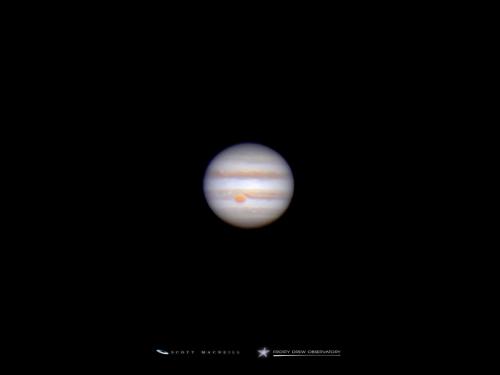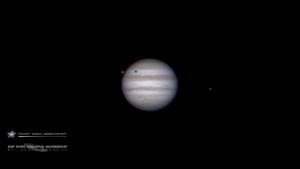Jupiter Returns for 2017
Have you noticed the two bright stars that have been rising around midnight for the past month? If you’ve been watching, you have certainly observed that the top star has been changing its position relative to the bottom star. That’s because the top star is not a star at all, but instead the planet Jupiter, which has been accompanying Spica, the brightest star in the constellation Virgo.
With each passing night, Jupiter has been rising earlier and earlier, with its rise time crossing into the night time sky (before midnight) on January 15th. The earlier rise times will make Jupiter easier to view for those who do not last into the early morning stargazing hours, with Jupiter eventually rising before sunset. Over the next month Jupiter will remain about 3.5° away from Spica in the night time sky as its movement from West to East, called pro-grade motion, appears to stop. In late February though, you will notice that Jupiter will begin to move away from Spica, back towards the west, this is called retrograde motion. These changes in Jupiter’s apparent motion across the sky are a product of Earth’s faster orbit around the Sun than Jupiter.
Jupiter takes 11.86 Earth-years to complete one full orbit around the Sun, which means that Earth will complete nearly 12 orbits for every one that Jupiter makes. Every year as Earth orbits passed Jupiter on the same side of the Sun, background stars beyond Jupiter will appear to progress across the night sky faster than Jupiter, this effect is called parallax and will make Jupiter appear to move backwards in the sky. Once Earth arrives, in our orbit around the Sun, on the opposite side of the Sun than Jupiter, Jupiter will resume its forward motion across the sky. This will cause Jupiter to arrive close to Spica again in late August, and early September just after sunset.
Jupiter is a fabulous target for binoculars and telescopes of all sizes with different features becoming visible depending on your devices aperture. Binoculars and small telescopes will easily showcase the four Galilean Moon’s of Jupiter, whose positions will change on an daily basis, some on an hourly basis. Small backyard telescopes will easily show Jupiter’s equatorial bands with more than a hint of the Great Red Spot. Higher aperture backyard telescopes will easily see the Great Red Spot, shadow transits; which occur when the Galilean Moons create solar eclipses on Jupiter, and other smaller storms in Jupiter’s turbulent atmosphere. Add in that Jupiter will be close to Spica, a blue star for much of the winter, we will get a nice contrast of Jupiter’s rather yellowish color against Spica’s sapphire blue.
Spend some time over the next few months with Jupiter. The views are fantastic and the opportunities to catch the Great Red Spot, shadow transits, and changing configurations of the Galilean Moons are numerous and make Jupiter a unique target for observation. If you do not have a telescope or binoculars, be sure to catch Jupiter when it’s close to Spica and see if you can notice the difference in color. Jupiter is regular showcased in the Frosty Drew telescope on Friday nights and our 2017 viewing season for Jupiter begins just about now, early February. Do it!
Get rise times for Jupiter applicable to Southern New England and largely the U.S. East Coast
Check out some of the photos we have captured of Jupiter at Frosty Drew Observatory.
Geek out with scientific data on Jupiter.
-Scott
- Author:
- Scott MacNeill
- Entry Date:
- Feb 1, 2017
- Published Under:
- Scott MacNeill's Columns




